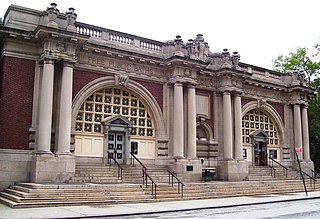
Public baths originated when most people in population centers did not have access to private bathing facilities. Though termed "public", they have often been restricted according to gender, religious affiliation, personal membership, and other criteria.
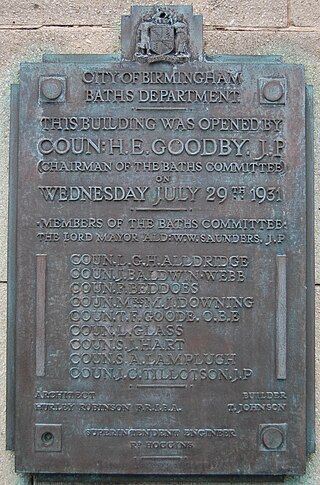
The Birmingham Baths Committee was an organisation responsible for the provision and maintenance of public swimming and bathing facilities. Birmingham City Council funded, constructed and ran bathing facilities throughout the city. The movement to develop baths and wash houses in Britain had its impetus with the rapid urbanisation of the Industrial Revolution, which was felt acutely in Birmingham, one of England's powerhouses.

Florin Court is an Art Deco / Streamline Moderne residential building on the eastern side of Charterhouse Square in Smithfield, London.
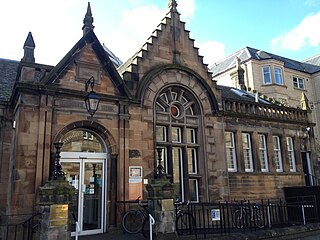
Warrender Swim Centre – traditionally known as Warrender Baths – is a swimming pool and fitness complex that opened in 1887 in Marchmont, Edinburgh.

The City Baths, located at 420 Swanston Street, Melbourne, Victoria, Australia, opened in 1904 as public baths, with swimming pools and bathing facilities. Extensively renovated in the early 1980s, it is now considered one of Melbourne's most architecturally and historically significant buildings.
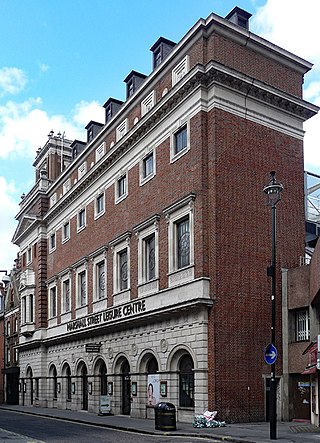
The Marshall Street Baths in Westminster, London, were built in 1850. They were closed for refurbishment in 1997 and reopened on 27 July 2010 as a modernised leisure centre. The building is noted for its architecture and is Grade II listed.
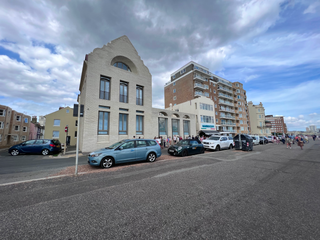
The original Medina House in Hove, Sussex, was the eastern of two seafront buildings, located on either side of Sussex Road, which together comprised Hove Baths, later to become more popularly known as the Medina Baths. The western building housed the men's baths, and the eastern building housed the women's baths.

A steam bath is a steam-filled room for the purpose of relaxation and cleansing. It has a long history, going back to Greek and Roman times.

The York Hall, officially known as York Hall Leisure Centre, is a multi-purpose indoor arena and leisure centre in Bethnal Green, London. The building opened in 1929 with a capacity of 1,200 and is now an international boxing venue. The main hall also hosts concerts and other live events and other facilities also include a local gymnasium and a swimming pool.

The Geibeltbad Pirna is a public bath and water sport facility in Pirna near Dresden, Saxony in Germany. Finished under the Nazis on June 20, 1937, it is one of the largest baths in the world. Completely paid by the Anna Marie Geibelt Foundation and constructed on a her mud area, between April - June 20, 1937 (three months construction only). The foundation got its inspiration from the International Hygiene Exhibition, were the public bath in that new form had been invented. The 20,000 square metre site was renovated and upgraded in 2001-02 to include an indoor swimming pool, wellness centre and other facilities. From 1937 to 1990 Geibeltbad was a venue for the German swimming championships as well as a training site. In 2006, the bath welcomed 233,588 visitors.

Oasis Sports Centre is a leisure centre in Holborn, London, operated by Better on behalf of the London Borough of Camden.

Southend Leisure & Tennis Centre is a sports centre located in Southend-on-Sea, Essex, England. The centre was built in March 1996 and expanded in November 2010, adding Southend Swimming and Diving Centre to the site, with a new reception area linking the two centres together with self-swiping turnstiles. The site's main name remained as Southend Leisure & Tennis Centre with the addition of Southend Swimming and Diving Centre. The centre is also known as Garon Park, as the buildings sit within the park site. The centre is run by Fusion Lifestyle.
Thermal baths or spas in Budapest are popular tourist attractions as well as public comforts for the city's residents.

The Harold Holt Memorial Swimming Centre is a public swimming pool complex located on the corner of High Street and Edgar Street, Glen Iris, Melbourne, Australia. Built in the 1960s by Australian architects Kevin Borland and Daryl Jackson, the Swimming Centre is considered to be a fine example of Brutalist architecture. Originally built in 1927 as a municipal swimming baths, the facilities were renovated in 1967 by Borland and Jackson to accommodate for higher swimming participation numbers. It is named in honour of Prime Minister Harold Holt, the local member of parliament until his apparent drowning death while the facility was under construction.

Spanien Public Baths, colloquially known simply as Spanien, is a public bath house and a listed building in Aarhus, Denmark. The bath house was completed in 1931 and was listed on the Danish national registry of protected buildings and places by the Danish Heritage Agency on 15 February 1989 as a fine example of the Nordic funkis style. The building was thoroughly renovated in 2010–12.

Portobello Swim Centre is a multi-facility leisure venue in Portobello, Edinburgh. Built by Edinburgh City Architect Robert Morham in 1898, it comprises swimming pools, a gym and fitness studio, and Edinburgh's only authentic and publicly available Victorian Turkish bath, one of three remaining in Scotland, and one of only eleven in the whole of the UK. The salt water baths were completed in 1901.
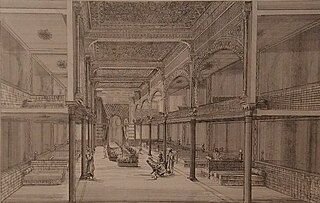
The Victorian Turkish bath is a type of bath in which the bather sweats freely in hot dry air, is then washed, often massaged, and has a cold wash or shower. It can also mean, especially when used in the plural, an establishment where such a bath is available.

The Victorian Turkish baths was a private bathing house at Lincoln Place, Dublin, Ireland opened on 2 February 1860.

The Carlisle Turkish baths were an Edwardian public baths in Carlisle, Cumbria, England. They adjoined the city's 1884 swimming pool and were constructed in 1908-1909. The baths offered saunas, plunge pools and shower and were advertised as providing health benefits to patrons. These typical Victorian-style Turkish baths remained in use until November 2022 and retain their original tiling and faience work, which is of unusually good quality. A local campaign is seeking to reopen the baths.

Swindon Victorian Turkish Baths are Victorian Turkish baths in Swindon, England.




















